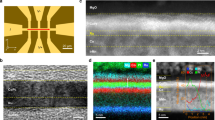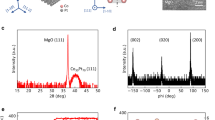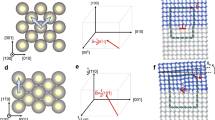Abstract
Modern magnetic-memory technology requires all-electric control of perpendicular magnetization with low energy consumption. While spin–orbit torque (SOT) in heavy metal/ferromagnet (HM/FM) heterostructures1,2,3,4,5 holds promise for applications in magnetic random access memory, until today, it has been limited to the in-plane direction. Such in-plane torque can switch perpendicular magnetization only deterministically with the help of additional symmetry breaking, for example, through the application of an external magnetic field2,4, an interlayer/exchange coupling6,7,8,9 or an asymmetric design10,11,12,13,14. Instead, an out-of-plane SOT15 could directly switch perpendicular magnetization. Here we observe an out-of-plane SOT in an HM/FM bilayer of L11-ordered CuPt/CoPt and demonstrate field-free switching of the perpendicular magnetization of the CoPt layer. The low-symmetry point group (3m1) at the CuPt/CoPt interface gives rise to this spin torque, hereinafter referred to as 3m torque, which strongly depends on the relative orientation of the current flow and the crystal symmetry. We observe a three-fold angular dependence in both the field-free switching and the current-induced out-of-plane effective field. Because of the intrinsic nature of the 3m torque, the field-free switching in CuPt/CoPt shows good endurance in cycling experiments. Experiments involving a wide variety of SOT bilayers with low-symmetry point groups16,17 at the interface may reveal further unconventional spin torques in the future.
This is a preview of subscription content, access via your institution
Access options
Access Nature and 54 other Nature Portfolio journals
Get Nature+, our best-value online-access subscription
$29.99 / 30 days
cancel any time
Subscribe to this journal
Receive 12 print issues and online access
$259.00 per year
only $21.58 per issue
Buy this article
- Purchase on Springer Link
- Instant access to full article PDF
Prices may be subject to local taxes which are calculated during checkout





Similar content being viewed by others
Data availability
The authors declare that the main data supporting the findings of this study are available within the Letter and its Supplementary Information. Extra data are available from the corresponding author upon reasonable request. Source data are provided with this paper.
References
Miron, I. M. et al. Perpendicular switching of a single ferromagnetic layer induced by in-plane current injection. Nature 476, 189–193 (2011).
Liu, L. et al. Spin-torque switching with the giant spin Hall effect of tantalum. Science 336, 555–558 (2012).
Manchon, A. et al. Current-induced spin-orbit torques in ferromagnetic and antiferromagnetic systems. Rev. Mod. Phys. 91, 035004 (2019).
Liu, L., Lee, O. J., Gudmundsen, T. J., Ralph, D. C. & Buhrman, R. A. Current-induced switching of perpendicularly magnetized magnetic layers using spin torque from the spin Hall effect. Phys. Rev. Lett. 109, 096602 (2012).
Pai, C. F. et al. Spin transfer torque devices utilizing the giant spin Hall effect of tungsten. Appl. Phys. Lett. 101, 122404 (2012).
Lau, Y. C., Betto, D., Rode, K., Coey, J. M. D. & Stamenov, P. Spin–orbit torque switching without an external field using interlayer exchange coupling. Nat. Nanotechnol. 11, 758–762 (2016).
Oh, Y. W. et al. Field-free switching of perpendicular magnetization through spin–orbit torque in antiferromagnet/ferromagnet/oxide structures. Nat. Nanotechnol. 11, 878–884 (2016).
Fukami, S., Zhang, C., DuttaGupta, S., Kurenkov, A. & Ohno, H. Magnetization switching by spin–orbit torque in an antiferromagnet–ferromagnet bilayer system. Nat. Mater. 15, 535–541 (2016).
van den Brink, A. et al. Field-free magnetization reversal by spin-Hall effect and exchange bias. Nat. Commun. 7, 10854 (2016).
Yu, G. et al. Switching of perpendicular magnetization by spin–orbit torques in the absence of external magnetic fields. Nat. Nanotechnol. 9, 548–554 (2014).
You, L. et al. Switching of perpendicularly polarized nanomagnets with spin orbit torque without an external magnetic field by engineering a tilted anisotropy. Proc. Natl Acad. Sci. USA 112, 10310–10315 (2015).
Liu, L. et al. Current-induced magnetization switching in all-oxide heterostructures. Nat. Nanotechnol. 14, 939–944 (2019).
Safeer, C. K. et al. Spin–orbit torque magnetization switching controlled by geometry. Nat. Nanotechnol. 11, 143–146 (2016).
Kong, W. J. et al. Spin–orbit torque switching in a T-type magnetic configuration with current orthogonal to easy axes. Nat. Commun. 10, 233 (2019).
Baek, Sh. C. et al. Spin currents and spin–orbit torques in ferromagnetic trilayers. Nat. Mater. 17, 509–513 (2018).
Laref, S., Kim, K. W. & Manchon, A. Elusive Dzyaloshinskii-Moriya interaction in monolayer Fe3GeTe2. Phys. Rev. B 102, 060402 (2020).
Johansen, Ø., Risinggård, V., Sudbø, A., Linder, J. & Brataas, A. Current control of magnetism in two-dimensional Fe3GeTe2. Phys. Rev. Lett. 122, 217203 (2019).
Iwata, S., Yamashita, S. & Tsunashima, S. Perpendicular magnetic anisotropy and magneto-optical Kerr spectra of MBE-grown PtCo alloy films. IEEE Trans. Magn. 33, 3670–3672 (1997).
Dannenberg, A., Gruner, M. E., Hucht, A. & Entel, P. Surface energies of stoichiometric FePt and CoPt alloys and their implications for nanoparticle morphologies. Phys. Rev. B 80, 245438 (2009).
MacNeill, D. et al. Control of spin–orbit torques through crystal symmetry in WTe2/ferromagnet bilayers. Nat. Phys. 13, 300–305 (2017).
Suzuki, D., Ohtake, M., Kirino, F. & Futamoto, M. Preparation of CoPt-alloy thin films with perpendicular magnetic anisotropy on MgO(111), SrTiO3(111), and Al2O3(0001) single-crystal substrates. IEEE Trans. Magn. 48, 3195–3198 (2012).
Garello, K. et al. Symmetry and magnitude of spin–orbit torques in ferromagnetic heterostructures. Nat. Nanotechnol. 8, 587–593 (2013).
Hayashi, M., Kim, J., Yamanouchi, M. & Ohno, H. Quantitative characterization of the spin-orbit torque using harmonic Hall voltage measurements. Phys. Rev. B 89, 144425 (2014).
Pi, U. H. et al. Tilting of the spin orientation induced by Rashba effect in ferromagnetic metal layer. Appl. Phys. Lett. 97, 162507 (2010).
Kim, J. et al. Layer thickness dependence of the current-induced effective field vector in Ta|CoFeB|MgO. Nat. Mater. 12, 240–245 (2013).
Guillemard, C., Petit-Watelot, S., Andrieu, S. & Rojas-Sánchez, J. C. Charge-spin current conversion in high quality epitaxial Fe/Pt systems: isotropic spin Hall angle along different in-plane crystalline directions. Appl. Phys. Lett. 113, 262404 (2018).
Pai, C.-F., Mann, M., Tan, A. J. & Beach, G. S. D. Determination of spin torque efficiencies in heterostructures with perpendicular magnetic anisotropy. Phys. Rev. B 93, 144409 (2016).
Železný, J. et al. Spin-orbit torques in locally and globally noncentrosymmetric crystals: antiferromagnets and ferromagnets. Phys. Rev. B 95, 014403 (2017).
Acknowledgements
This research is supported by the Singapore National Research Foundation under CRP Award No. NRF-CRP10-2012-02 and the Singapore Ministry of Education MOE2018-T2-1-019 and MOE2018-T2-2-043, A*STAR Grant No. A1983C0036, A*STAR IAF-ICP 11801E0036, MOE Tier1 R-284-000-195-114 and the King Abdullah University of Science and Technology (KAUST). J.S.C. is a member of the Singapore Spintronics Consortium (SG-SPIN).
Author information
Authors and Affiliations
Contributions
L.L. and J.S.C. conceived and designed the experiments. L.L. and C.Z. performed the thin film deposition, device fabrication, transport measurements and data analysis. A.M. theoretically proposed the 3m torque and performed the calculations. T.Z., X.S., J.D., Q.X., S.C., S.S. and J.Y. contributed to the thin film deposition and device fabrication. W.L., J.Z., R.G., H.W. and P.Y. contributed to the data analysis. C.L. and S.P. performed the STEM experiments. L.L., C.Z., A.M. and J.S.C. wrote the manuscript and all authors contributed to its final version.
Corresponding authors
Ethics declarations
Competing interests
The authors declare no competing interests.
Additional information
Peer review information Nature Nanotechnology thanks Byong-Guk Park and the other, anonymous, reviewer(s) for their contribution to the peer review of this work.
Publisher’s note Springer Nature remains neutral with regard to jurisdictional claims in published maps and institutional affiliations.
Supplementary information
Supplementary Information
Supplementary Sections 1–14, Figs. 1–38 and refs. 1–4.
Source data
Rights and permissions
About this article
Cite this article
Liu, L., Zhou, C., Shu, X. et al. Symmetry-dependent field-free switching of perpendicular magnetization. Nat. Nanotechnol. 16, 277–282 (2021). https://doi.org/10.1038/s41565-020-00826-8
Received:
Accepted:
Published:
Issue Date:
DOI: https://doi.org/10.1038/s41565-020-00826-8
This article is cited by
-
Field-free switching of perpendicular magnetization by two-dimensional PtTe2/WTe2 van der Waals heterostructures with high spin Hall conductivity
Nature Materials (2024)
-
Acoustic spin rotation in heavy-metal-ferromagnet bilayers
Nature Communications (2024)
-
The central role of tilted anisotropy for field-free spin–orbit torque switching of perpendicular magnetization
NPG Asia Materials (2024)
-
Highly efficient field-free switching of perpendicular yttrium iron garnet with collinear spin current
Nature Communications (2024)
-
Effective electrical manipulation of a topological antiferromagnet by orbital torques
Nature Communications (2024)



